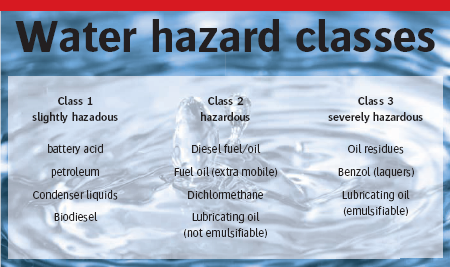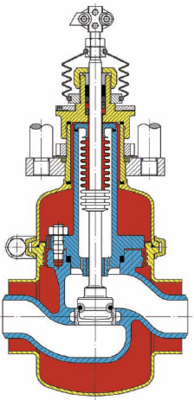In the interest of water pollution control, according to the Umweltbundesamt (German Federal Environment Agency), plants for handling water-polluting substances must be built and operated so that no pollution or adverse change in water occurs. According to it, valves, containers and connecting pipes which contain or transport hazardous substances, must therefore be equipped with liquid-tight collecting basins or a double, monitorable wall. The materials used in plants for handling water-polluting substances are examined and classifi ed according to their water-polluting qualities. The classifi cation is carried out according to the administrative ordinance for water-polluting substances (VwVwS), whereby these must be assigned to corresponding water pollution categories (Ill. 1.). The concrete baths with single-walled containers often used for water-polluting and slightly liquid media are, however, usually too expensive and offer only inadequate protection. In particular, with highly volatile substances, e.g. diluents, kerosene, diesel oil, petrol, benzene etc., like those frequently used in the chemicals, and also the paint industry, one collecting basin is usually not suffi cient. Therefore, secondary safety measures are necessary, in order to avoid an escape of water-polluting liquids from storage containers and valves. As an alternative to a single-walled container with concrete tub, a double-walled tank can be used, which can be emptied via a control valves like the type 600. This fi tting, an optimized version of the TEBO control valve, has a doublewalled construction and is fi rmly respectivly undetachiable connected to the storage tank, so that it forms an integral part of the tank. The type-tested valve with DiBT approval has a pneumatic drive which automatically goes to the closed position in the event of a lack of compressed air. Up to this control valve, doublewalled construction is legally stipulated. Up to the valve end, the double-walled container is under a static pressure which is limited. After this valve the pipe continues as a single-walled version. For this reason it is also necessary to continuously monitor the valve closure in terms of its tightness. For this purpose, therefore, a single-walled fi tting is installed following the double-walled fi tting and the pipe section between the two fi ttings impinged with pressure in order to be able to check a loss of pressure. If a loss of pressure in the pipe is registered, this indicates a leakage in the pipe section described above or in one of the two valves. One option for the further reduction of costs is to equip the double-walled valve with leakage monitoring. As a result of this, the single-walled valve as well as the pipe section between the two fittings need not be monitored. As the type 600 double-walled valve is about one-third smaller and weighs around half as much as its predecessor, it can also be integrated more easily and very fl exibly into the most varied installation spaces. The interior body of the valve was calculated according to the fi nite elements method, as a result of which, the pressure bearing wall could be made even thinner. The big difference in the wall thicknesses that is usual in constructions with a cast body, could thus be largely eliminated. The possibility of leaks in comparison with conventional cast constructions is lower due to the considerably more homogeneous valve wall. In addition, it was possible to signifi cantly increase the strength of the valve thanks to the fi nite elements method. Whereas a nominal pressure load of 40 bar is specifi ed for the TEBO, the type 600 has a very high nominal pressure load of 100 bar. Furthermore the precision casting inner body offers even better flow characteristics and therefore greater efficiency due to lower fl ow resistance. Characteristic of these double-walled control valves from, the second wall is added very close to the pressure-bearing wall of the valve. The space between this double wall, as a rule, is free of pressure and only comes into action in the event of leaks on the inner valve wall. In principle, on such double-walled valves, metal bellows are used instead of the otherwise customary stuffing box packing. Thus the risk factor of the spindle seal is excluded and it is simultaneously ensured that no openings exist below the liquid surface. Since the double sheath encloses the complete valve, the system can be assembled in practically every mounting position. The wall around the valve consists of pressed, standardized parts, making a high quality of the components and simultaneously lower production costs possible. As a result of the “T-piece in T-piece” construction, thermal bridges could be prevented in the realization of the double wall. For the monitoring of the grommet (valve cone), the sealing cone was equipped with two sealing rings. The space between the sealing rings can thus be used for the monitoring of inner leakage. The double-walled valve type 600 is suitable, among other things, not only for water polluting liquids in accordance with water pollution categories (WGK) 3 and 2, but also for liquid cryogenics, whereby here high diffusion tightness is guaranteed. In addition, the valve can be used as a cost and space-saving alternative to previous solutions for various gasses and in this connection, among other things, also for the high temperature range, e.g. in biogas plants. Depending on the application, the type 600 is appropriately modified, whereby however, the essential valve principle is retained.
Double-Wall Valves with Leakage Monitoring
Plants for handling water-polluting substances must be built and operated so that no pollution or adverse change in water occurs. The applied valves, containers and connecting pipes play an important role in this.
- by Daume Regelarmaturen GmbH
- March 7, 2010
- 532 views


















